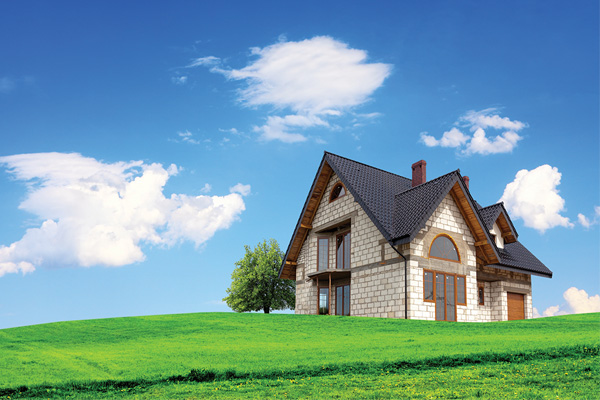House sizes are coming down, but the size of apartments is going up.
According to preliminary data from the Census Bureau, the square footage of new single-family homes in last year’s final quarter continued its downward trend after years of marching ever higher.
The median floor area of a single-family home was 2,371 square feet in the fourth quarter of 2017. In the fourth quarter of 2016, the median was 2,440 square feet. (Median is more representative than average, because the figure is not skewed by outlier super-size houses.)
The lowest median point in the most recent cycle was 2,135 square feet in 2009.
“The post-recession increase in single-family home size is consistent with the historical pattern coming out of recessions,” explains Robert Dietz, chief economist at the National Association of Home Builders.
Typically, the size of new homes falls prior to and during a recession as buyers tighten budgets. Then sizes rise as high-end buyers, who face fewer credit constraints, return to the housing market in relatively greater proportions.
Dietz reports that the normal pattern was exacerbated during the current business cycle due to market weakness among first-time buyers and supply-side constraints in the building market. But the recent declines in size indicate that this part of the cycle has ended, he says, and house sizes will continue to trend lower as builders add more entry-level homes into their inventories.
On the other hand, apartment sizes are trending larger, as developers take aim at baby boomers, who are giving up their big houses for smaller – but not too small – apartments.
According to recent data from Transwestern, a full-service commercial realty firm based in Houston, the average one-bedroom apartment has 874 square feet, while two-bedroom units average 903 square feet, and three-bedrooms ring in at 976.
However, apartments in properties constructed in the last 12 months average 935 square feet for a one-bedroom, 945 square feet for a two-bedroom and 996 square feet for a three-bedroom.
To meet demand for the larger rentals, developers are building a larger percentage of three-bedroom units.
- ••••
With apologies to Sports Illustrated, here are three signs that the real estate apocalypse is nigh:
- David Sicilia, the Henry Kaufman Associate Professor of Financial History at the University of Maryland, believes that real estate agents will eventually go the way of the dodo. Asked by the school’s Terp magazine what mainstay of American life will have vanished in 25 years, Sicilia responded: “Realtors are headed for extinction.”
His reasoning: “The occupation owes its existence chiefly to the Multiple Listing Service, a former monopoly on market information that is rapidly migrating to the internet. Software is coming that will price to market with much greater precision and objectivity than real estate agents’ intuition. Video property tours make scouting from the laptop simple.”
For more serious, in-person visits to houses for sale, the professor envisions “bonded, paid-by-the-hour docents escorting prospective buyers through properties.” He also thinks “an increasingly friction-free economy will eliminate real estate agents’ enormous fees.”
- 35 percent of buyers who took the plunge last year said they made an offer on their home without first seeing it in person, according to a December 2017 survey commissioned by Redfin. That’s up from 19 percent in June 2016. The survey found that millennials were the most likely to make a sight-unseen bid, reflecting their comfort level with relying on information they find online.
- Another Redfin survey asked would-be buyers what they’d do if mortgage rates hit 5 percent. Six percent of respondents said they would drop out of the market altogether, and 25 percent would slow their plans to buy. But 20 percent said they would speed up their search and jump on a home they liked, for fear that rates would rise even higher.
- ••••
When it’s cold outside, most homeowners turn up their electric or natural gas furnaces. But some of us – 1.9 percent, the Census Bureau reports – rely on wood for heat.
Most of the counties with a population of at least 65,000 where residents use wood to keep warm are in the West. A sampling of places that keep the fire burning: In Apache County, Arizona, 60.6 percent of dwellings are heated by wood; New Mexico’s McKinley County, 38.8 percent; California’s Mendocino County, 24.8 percent; New York’s St. Lawrence County, 17.5 percent (the only Eastern county in the top 10).
- ••••
In less than two decades, America’s population will join Japan’s as the one of the oldest on Earth.
By 2035, the Census Bureau projects that older adults will edge out children in population size. People age 65 and over are expected to number 78 million, while children under age 18 will number 76.4 million.
Looking out farther, nearly one in four Americans will be 65 or older by 2060, the number of 85-plus adults will triple, and the country will add a half-million centenarians.
Japan currently has the world’s oldest population, where more than one in four people is at least 65 years old.
Lew Sichelman has been covering real estate for more than 30 years. He is a regular contributor to numerous shelter magazines and housing and housing-finance industry publications. Readers can contact him at lsichelman@aol.com.

